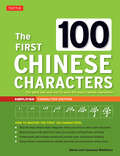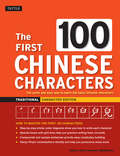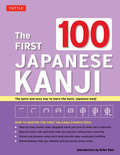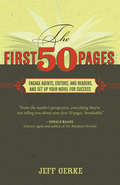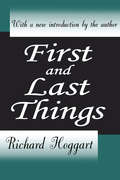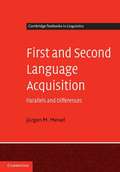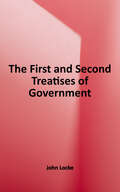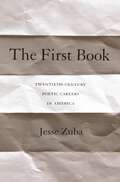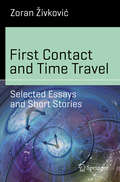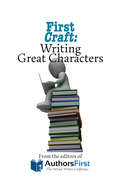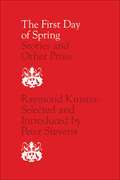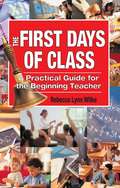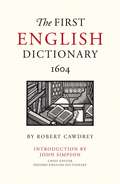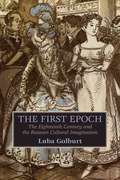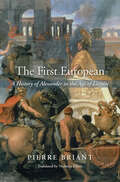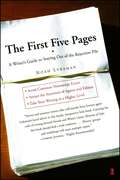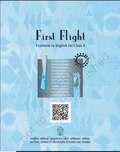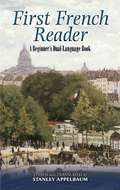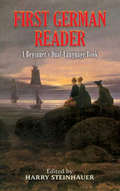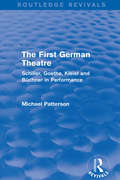- Table View
- List View
The First 100 Chinese Characters: Simplified Character Edition
by Alison Matthews Laurence MatthewsThis book is a quick and easy way to learn basic Chinese Characters.All beginning students of Chinese struggle to memorize and learn to write the Chinese characters. The First 100 Chinese Characters adopts a structural approach which helps students to quickly master the basic characters that are fundamental to this language.The English meanings, pronunciations in hanyu pinyin and alternate forms (if any) for each Chinese character are presented along with a stroke order guide and spaces for writing practice. Printed with gray guidelines, the stroke order guides are designed to be traced over to teach students the standard sequence of strokes used to write the character. Related compounds and phrases are given to assist in vocabulary building. Three indexes at the back allow the characters to be looked-up by their English meanings, hanyu pinyin pronunciations, or radicals. Extra practice sheets are also provided.This book contains: Step-by-step stroke order diagrams show you how to write each character. Special boxes with grid lines help you practice writing them correctly. Compounds and sample sentences provide easy vocabulary building. Hanyu pinyin romanizations identify and help you pronounce every word.
The First 100 Chinese Characters: Traditional Character Edition
by Laurence Matthews Alison MatthewsThis book is a quick and easy way to learn the first 100 basic Chinese traditional characters.For effective leaning, memorization and practice, each Chinese character is shown separately on a single page, together with its English definitions, hanyu pinyin romanization, alternate form (if any), a stroke order guide and ample space for writing practice. Printed in gray lines, the stroke order guides introduce the student to the standard stroke sequence used in writing the characters, by tracing over them. After learning the correct stroke order, the student can then practice writing the character on their own, thus reinforcing recognition and memorization. Large boxes with grids for correct proportions are provided. Related compounds and phrases containing each character are also included to assist in vocabulary building. Three indexes (alphabetically by the English meanings and the pinyin romanization, and by radicals) are provided at the back of the book for quick and esy reference, along with extra sheets of blank boxes for writing practice. Featured are:The 100 most frequently-used Chinese charactersFoundation characters for the HSK A level language proficiency testStandard hanyu pinyin romanizationsStep-by-step stroke order guides and ample space for writing practiceOver 500 words and phrases containing the basic charactersConcise English definitions
The First 100 Japanese Kanji
by Eriko SatoThis is an invaluable study guide for learning basic Japanese characters.The first 100 Japanese Kanji is intended for beginning students, or experienced speakers who need to practice their written Japanese. Kanji are an essential part of the Japanese language and together with kana (hiragana and katakana) comprise the written component of Japanese.This book presents the kanji characters that are most commonly used. They have been carefully selected for rapid and effective learning. Each kanji's readings, meanings, and common compounds are presented, and romanized pronunciations for English speakers (romanji) are included as well. Printed with gray guidelines, stroke order guides are designed to be traced over to teach students the standard sequence of strokes used to write each character. Three indexes at the back allow the characters to be looked up as with a dictionary or by their readings. Students who wish to practice writing kanji will find extra practice sheets available.This book includes:Step-by-step stroke order diagrams for each characterSpecial boxes with grid lines to practice writing charactersWords and phrases using each kanjiRomanizations (romanji) to help identify and pronounce every word
The First 100 Japanese Kanji
by Eriko SatoThis is an invaluable study guide for learning basic Japanese characters.The first 100 Japanese Kanji is intended for beginning students, or experienced speakers who need to practice their written Japanese. Kanji are an essential part of the Japanese language and together with kana (hiragana and katakana) comprise the written component of Japanese.This book presents the kanji characters that are most commonly used. They have been carefully selected for rapid and effective learning. Each kanji's readings, meanings, and common compounds are presented, and romanized pronunciations for English speakers (romanji) are included as well. Printed with gray guidelines, stroke order guides are designed to be traced over to teach students the standard sequence of strokes used to write each character. Three indexes at the back allow the characters to be looked up as with a dictionary or by their readings. Students who wish to practice writing kanji will find extra practice sheets available.This book includes:Step-by-step stroke order diagrams for each characterSpecial boxes with grid lines to practice writing charactersWords and phrases using each kanjiRomanizations (romanji) to help identify and pronounce every word
The First 50 Pages: Engage Agents, Editors and Readers, and Set Your Novel Up For Success
by Jeff GerkeWhether you're looking to get published or just hoping to hook your reader, first impressions are vital. Compelling opening scenes are the key to catching an agent of editor's attention, and are crucial for keeping your reader engaged.
First and Last Things
by Richard HoggartPart meditation, part commonplace book, First and Last Things is an attempt by a writer of great distinction and strong convictions to take stock of his beliefs and values. Here, Richard Hoggart considers the big questions without shortchanging readers with easy answers. He examines problems (as he sees them) of faith; the mysterious origins of conscience; the importance of family and friends; the value of literature; the nature of memory; and the need, in old age, to find some value in existence. To these issues, and many others, the author brings a lifetime of rich experience and a mind well stocked with the best that has been written by those who have gone before. What emerges above all in this work is Richard Hoggart's love of, almost obsession with, quotations from great authors, especially, of course, Shakespeare. He muses on the business of capitalism and democracy, noting a reluctant conclusion that democracy is the least worst form of government, and that capitalism is its inevitable partner, but one which democratic societies should treat with "a very long spoon." He argues that market and consumer driven societies are inevitably led to relativism, head-counting, and populism. The result is a book that is introspective without being self-absorbed, that is thought-provoking but never preaching, that is, profound without being portentous. First and Last Things is a work that the young should read, if only to discover how much there is still to understand, and one that the old will treasure.
First and Second Language Acquisition
by Jürgen M. MeiselInfants and very young children develop almost miraculously the ability of speech, without apparent effort, without even being taught - as opposed to the teenager or the adult struggling without, it seems, ever being able to reach the same level of proficiency as five year olds in their first language. This useful textbook serves as a guide to different types of language acquisition: monolingual and bilingual first language development and child and adult second language acquisition. Unlike other books, it systematically compares first and second language acquisition, drawing on data from several languages. Research questions and findings from various subfields are helpfully summarized to show students how they are related and how they often complement each other. The essential guide to studying first and second language acquisition, it will be used on courses in linguistics, modern languages and developmental psychology.
The First and Second Treatises of Government
by John LockeLocke's two groundbreaking treatises regarding good governance are present here in this complete edition. At the time these treatises were written, English politics had undergone decades of upheaval in the wake of the English Civil War. <p><p> When Dutch monarch William of Orange ascended to the English throne in the Glorious Revolution of 1688, burning questions over the best form of governance for England were prominent in the intelligentsia of the era. It was a time when England grappled with its incremental transition from monarchy to early forms of democracy and right to vote, where dynastic monarchy and religious theory still held considerable power over the formation of the state. <p><p> In the first treatise Locke proceeds to attack and dissect his prominent contemporary Robert Filmer, who was broadly in favour of absolute monarchy under the principle of divine right. The allusions to the Biblical Adam, wherein the monarch can be intimated as a continuation of the first man ever created, are debunked by Locke who asserts that God never asserted that one man had province to rule over all other human beings. Supporting his argument with known history, Locke concludes that no king over the centuries had asserted to be the heir of Adam and thereby the rightful ruler of a country. <p><p> In the second treatise Locke turns to a different topic - that of the state of nature. He discusses how humanity may have behaved prior to the establishment of formal societies, and concludes that humanity - even without an established government in place - had never been truly lawless even when freedom was at its farthest extent. In arguing against the tyranny of absolute monarchy, while acknowledging the advantages of humanity's freedom in its natural ungoverned state, Locke arrives at his conclusion: a democratically elected government, whereby humans are accorded freedoms but must conform to the rule of law, is the most advantageous type of government to which humans can aspire. <p><p> Lauded as a classic of political philosophy, the treatises by Locke are a common requirement in various educational courses concerning political science and philosophy to this day. While steeped in the historical realities of the late 17th century, the arguments Locke composes for governance favourable to the people and their country's development were immensely influential on political theory during and after the Enlightenment era.
The First Book: Twentieth-Century Poetic Careers in America
by Jesse Zuba"We have many poets of the First Book," the poet and critic Louis Simpson remarked in 1957, describing a sense that the debut poetry collection not only launched the contemporary poetic career but also had come to define it. Surveying American poetry over the past hundred years, The First Book explores the emergence of the poetic debut as a unique literary production with its own tradition, conventions, and dynamic role in the literary market. Through new readings of poets ranging from Wallace Stevens and Marianne Moore to John Ashbery and Louise Glück, Jesse Zuba illuminates the importance of the first book in twentieth-century American literary culture, which involved complex struggles for legitimacy on the part of poets, critics, and publishers alike. Zuba investigates poets' diverse responses to the question of how to launch a career in an increasingly professionalized literary scene that threatened the authenticity of the poetic calling. He shows how modernist debuts evoke markedly idiosyncratic paths, while postwar first books evoke trajectories that balance professional imperatives with traditional literary ideals. Debut titles ranging from Simpson's The Arrivistes to Ken Chen's Juvenilia stress the strikingly pervasive theme of beginning, accommodating a new demand for career development even as it distances the poets from that demand.Combining literary analysis with cultural history, The First Book will interest scholars and students of twentieth-century literature as well as readers and writers of poetry.
First Buddhist Women
by Susan MurcottFirst Buddhist Women is a readable, contemporary translation of and commentary on the enlightenment verses of the first female disciples of the Buddha. Through the study of the Therigatha, the earliest-known collection of women's religious poetry, the book explores Buddhism's 2,600-year-long liberal attitude toward women. Utilizing commentary and storytelling, author Susan Murcott traces the journey of wives, mothers, teachers, courtesans, prostitutes, and wanderers who became leaders in the Buddhist community, acquiring roles that even today are rarely filled by women in other, patriarchal religions.
First Contact and Time Travel: Selected Essays and Short Stories (Science and Fiction)
by Zoran ŽivkovićThis volume collects both essays and fictional material around two core topics in the long career of the Serbian writer, essayist, researcher, publisher and translator. The first topic - first contact - is chiefly represented by his comprehensive essay on "The Theme of First Contact in the SF Works of Arthur C. Clarke" and reflected on the literary level with his short stories "The Bookshop" and "The Puzzle". Two shorter essays on the second topic - time travel in SF literature - introduce, amongst others, the well-known and fascinating mosaic novel Time Gifts, which skillfully explores the more literary side of the notions of past, present and future. In the annotations the author provides insights into his take on the subjects presented.
First Craft: Writing Great Characters
by Editors of Authors FirstAn invaluable guide for fiction writers who want to learn how to create unforgettable characters. Readers love fiction first and foremost because they get to LIVE in the stories they read. The story's characters are the conduit to that experience, and storytellers that create memorable, relatable characters connect with readers at the most fundamental level. All fiction writers need to master the skills involved in creating great characters if they're going to connect with a meaningful audience. The challenge, of course, is that creating great characters is anything but easy. So how do you do it? Let the contributors to this book - all established novelists - show you the way. From essentials like knowing your characters and giving them personality to more nuanced concepts like shading characters and even using places as characters, FIRST CRAFT: WRITING GREAT CHARACTERS is a brief text packed with advice gleaned from decades of writing experience. Each chapter includes illustrations from the author's own work along with useful exercises that will help your characters walk right off the page. FIRST CRAFT: WRITING GREAT CHARACTERS is presented by AuthorsFirst, the virtual writers conference that has dozens and dozens of craft sessions available online and that sponsors an annual fiction writing contest. Contributors to this volume include New York Times bestselling author Lou Aronica, national bestselling authors Mary Marcus, John L. Hart, and Emily Sue Harvey, acclaimed novelists Leora Skolkin-Smith and K.J. Steele, and praised memoirist Marcia Gloster.
The First Day of Spring: Stories and Other Prose
by Raymond Knister Peter Stevens Douglas LochheadRaymond Knister had a strong sense of commitment both to his own career and to literature, particularly Canadian literature. In his ten working years he proved himself a prolific writer with wide-ranging interests. Although his work has appeared in many anthologies of Canadian literature, there remains a great deal of out of print or unpublished material. This volume brings together not only for his more well-known stories but also all his unpublished stories, a few travel pieces, and several examples of his literary criticism. Knister's stories are often strongly regional, and draw on rural Ontario for their setting and characters. Collected together here for the first time is a group of sketches dealing anecdotally with life in a village in southwestern Ontario. Also included are two stories arising from his experiences as a cab driver in Chicago in the 1920s, 'Innocent Man,' and 'Hackman's Night.' His essays focusing on literary matters and the traditions and problems of Canadian literature show a keenly critical mind. The First Day of Spring is an important rediscovery of one of Canada's best writers of the 1920s.
The First Days of Class: A Practical Guide for the Beginning Teacher
by Rebecca WilkeThis easy-to-use, step-by-step guide takes you through everything you need to know in your first days, weeks, and months as a new teacher, from developing your plan book and filing system in August to updating your grade book and celebrating your success in June. Chapters cover diverse learners, classroom organization and management, curriculum and instruction, lesson planning, grading systems, professional development, and more. Practical and specific advice helps you build the right classroom environment, create “essential file folders,” make a curriculum calendar, and even find the right wall art!The First Days of Class provides all the tools of the trade for new, substitute, returning, and emergency credential teachers, including: Short, easy-to-reference sections within each chapterTip boxes at the end of every chapterClassroom material samples, including “Our Classroom Rules” and a calendar of multicultural celebrationsResources that include a “A Teacher’s Ten Commandments,” Recommended Reading, and Educational websites.
The First English Dictionary 1604
by John Simpson Robert CawdreyEnglish is one of the most complicated languages to learn, and its constantly evolving vocabulary certainly doesn't help matters. For centuries, men and women have striven to chronicle and categorize the expressions of the English language, and Samuel Johnson is usually thought to be their original predecessor.But that lineage is wrong: Robert Cawdrey published his Table Alphabeticall in 1604, 149 years before Johnson's tome, and it is now republished here for the first time in over 350 years. This edition, prepared from the sole surviving copy of the first printing, documents Cawdrey's fascinating selection of 2,543 words and their first-ever definitions. Cawdrey subtitled his dictionary "for the benefit of Ladies, Gentlewomen, and other unskilled folk," for his aim was not to create a comprehensive catalog, but rather an in-depth guide for the lesser educated who might not know the "hard usual English wordes, borrowed from the Hebrew, Greeke, Latine, or French." Each entry reveals an intriguing facet of early modern life and the cultural mores of the time. There are familiar terms--"geometrie" was defined as "the art of measuring the earth," and a "concubine" was described as a "harlot, or light huswife"--and amusingly idiomatic definitions: "prodigall" is "too riotous in spending," while "hecticke" is "inflaming the hart, and soundest parts of the bodie."
The First Epoch
by Luba GolburtModern Russian literature has two "first" epochs: secular literature's rapid rise in the eighteenth century and Alexander Pushkin's Golden Age in the early nineteenth. In the shadow of the latter, Russia's eighteenth-century culture was relegated to an obscurity hardly befitting its actually radical legacy. And yet the eighteenth century maintains an undeniable hold on the Russian historical imagination to this day. Luba Golburt's book is the first to document this paradox. In formulating its self-image, the culture of the Pushkin era and after wrestled far more with the meaning of the eighteenth century, Golburt argues, than is commonly appreciated. Why did nineteenth-century Russians put the eighteenth century so quickly behind them? How does a meaningful present become a seemingly meaningless past? Interpreting texts by Lomonosov, Derzhavin, Pushkin, Viazemsky, Turgenev, Tolstoy, and others, Golburt finds surprising answers, in the process innovatively analyzing the rise of periodization and epochal consciousness, the formation of canon, and the writing of literary history.
The First European: A History of Alexander in the Age of Empire
by Pierre Briant“A truly remarkable forgotten chapter of European intellectual history, laid out with passion and integrity.” (The Wall Street Journal)The exploits of Alexander the Great were so remarkable that for centuries after his death the Macedonian ruler seemed a figure more of legend than of history. Thinkers of the European Enlightenment, searching for ancient models to understand contemporary affairs, were the first to critically interpret Alexander’s achievements. As Pierre Briant shows, in the minds of eighteenth-century intellectuals and philosophers, Alexander was the first European: a successful creator of empire who opened the door to new sources of trade and scientific knowledge, and an enlightened leader who brought the fruits of Western civilization to an oppressed and backward “Orient.”In France, Scotland, England, and Germany, Alexander the Great became an important point of reference in discourses from philosophy and history to political economy and geography. Voltaire, Montesquieu, and Robertson asked what lessons Alexander’s empire-building had to teach modern Europeans. They saw the ancient Macedonian as the embodiment of the rational and benevolent Western ruler, a historical model to be emulated as Western powers accelerated their colonial expansion into Asia, India, and the Middle East.“This important work. . . . confirms once more that the life-trajectory of the Macedonian conqueror remains an inexhaustible cultural resource.” —Sanjay Subrahmanyam, University of California, Los Angeles, author of Empires Between Islam and Christianity
First Exposure to a Second Language
by Zhaohong Han Rebekah RastThe initial state of learner spontaneous input processing in foreign language learning, as well as the extent to which this processing leads to intake, is of central importance to theoreticians and teachers alike. In this collection of original studies, leading experts examine a range of issues, such as what learners do when faced with a language they know little or nothing about, what factors appear to mediate beginning learners' processing of input, how beginners treat two types of information - form and meaning - in the input, and how adult cognition deals with stimulus frequency at this initial stage. This book provides a microscopic view on learners' processing of foreign language input at the early stages of learning, and evaluates a variety of methodological options within the context of ab initio processing of foreign languages other than English, such as German, Korean, Norwegian, Polish, and Spanish.
The First Five Pages
by Noah LukemanIF YOU'RE TIRED OF REJECTION, THIS IS THE BOOK FOR YOU. Whether you are a novice writer or a veteran who has already had your work published, rejection is often a frustrating reality. Literary agents and editors receive and reject hundreds of manuscripts each month. While it's the job of these publishing professionals to be discriminating, it's the job of the writer to produce a manuscript that immediately stands out among the vast competition. And those outstanding qualities, says New York literary agent Noah Lukeman, have to be apparent from the first five pages. The First Five Pagesreveals the necessary elements of good writing, whether it be fiction, nonfiction, journalism, or poetry, and points out errors to be avoided, such as* A weak opening hook* Overuse of adjectives and adverbs* Flat or forced metaphors or similes* Melodramatic, commonplace or confusing dialogue* Undeveloped characterizations and lifeless settings* Uneven pacing and lack of progressionWith exercises at the end of each chapter, this invaluable reference will allow novelists, journalists, poets and screenwriters alike to improve their technique as they learn to eliminate even the most subtle mistakes that are cause for rejection. The First Five Pageswill help writers at every stage take their art to a higher -- and more successful -- level.
First Flight class 10 - JCERT
by Jharkhand Council of Educational Research and Training RanchiThe book "First Flight" is a textbook in English for Class X, aimed at developing students' language and literary skills. It includes a variety of genres like fiction, diary entries, and travelogues, which introduce students to diverse themes, such as individual and societal relationships, emotions, and historical figures like Nelson Mandela and Anne Frank. The stories emphasize moral lessons, critical thinking, and communication skills, while the accompanying poems and exercises encourage reflection on personal experiences.
First Flight class 10 - NCERT - 23 (English Textbook)
by National Council of Educational Research and Training"First Flight" is a textbook designed for Class X students by NCERT. It is an amalgamation of various literary pieces, from poems to short stories, aimed at enhancing the English proficiency of students. The content is thoughtfully curated to introduce students to diverse cultures, ideologies, and thought processes, while also providing moral and ethical lessons. Themes of resilience, courage, love, sacrifice, and the quintessential spirit of human nature are interwoven throughout the text. The book not only aids in developing linguistic abilities but also encourages students to reflect upon life's essential values and virtues. Regular exercises and questions at the end of each chapter ensure comprehension and retention, paving the way for a robust foundation in the English language.
The First Frame
by Pannill CampIn the late eighteenth century, a movement to transform France's theatre architecture united the nation. Playwrights, philosophers, and powerful agents including King Louis XV rejected the modified structures that had housed the plays of Racine and Molière, and debated which playhouse form should support the future of French stagecraft. In The First Frame, Pannill Camp argues that these reforms helped to lay down the theoretical and practical foundations of modern theatre space. Examining dramatic theory, architecture, and philosophy, Camp explores how architects, dramatists, and spectators began to see theatre and scientific experimentation as parallel enterprises. During this period of modernisation, physicists began to cite dramatic theory and adopt theatrical staging techniques, while playwrights sought to reveal observable truths of human nature. Camp goes on to show that these reforms had consequences for the way we understand both modern theatrical aesthetics and the production of scientific knowledge in the present day.
First French Reader: A Beginner's Dual-Language Book
by Stanley AppelbaumThis excellent anthology offers the beginning French-language student a first taste of some of the world's most significant prose. Chosen for both their eloquence and ease of reading, excerpts from such masterpieces as Les Misérables, The Red and the Black, Madame Bovary, Carmen, and The Three Musketeers will open new worlds for linguists. Readers will savor the words of fifty great writers of multiple genres from the seventeenth through twentieth centuries, including Voltaire, Rousseau, Balzac, Baudelaire, Dumas, Proust, and other literary virtuosos.Lucid and accessible, the unabridged English translations by Stanley Appelbaum appear on pages that face the original French text. Literature lovers, French-language students, and other readers will find this volume a fascinating exploration of French literature...and an invaluable aid to mastering one of the world's most romantic languages.
First German Reader: A Beginner's Dual-Language Book
by Harry SteinhauerDesigned expressly for the beginning German language student, here is an outstanding collection of fifty-two short stories, poems, essays, and anecdotes. Each selection has been specially chosen for its power to evoke German life and culture. This dual-language edition features precise English translations on pages that face the original German text. New students will enjoy the pleasure of reading great German literature from the very first page, as the selections have been arranged to accommodate the gradual improvement of language skills. Helpful vocabulary and language exercises are also included. First German Reader features the works of many of Germany's best writers, including Goethe, Hesse, Heine, Schiller, Hölderlin, and other literary virtuosos. The translations of Harry Steinhauer are vivid and true to the originals--and poetic in their own right. Literature lovers, German language students, and other readers will find this volume an accessible exploration of German literature . . . and an invaluable aid to mastering the German language.
The First German Theatre (Routledge Revivals): Schiller, Goethe, Kleist and Büchner in Performance
by Michael PattersonFirst published in 1990. The book surveys of the development of German theatre from a market sideshow into an important element of cultural life and political expression. It examines Schiller as ‘theatre poet’ at Mannheim, Goethe’s work as director of the court theatre at Weimar, and then traces the rapid commercial decline that made it difficult for Kleist and impossible for Büchner to see their plays staged in their own lifetime. Four representative texts are analysed: Schiller’s The Robbers, Goethe’s Iphigenia on Tauris, Kleist’s The Prince of Homburg, and Büchner’s Woyzeck. This title will be of interest to students of theatre and German literature.
